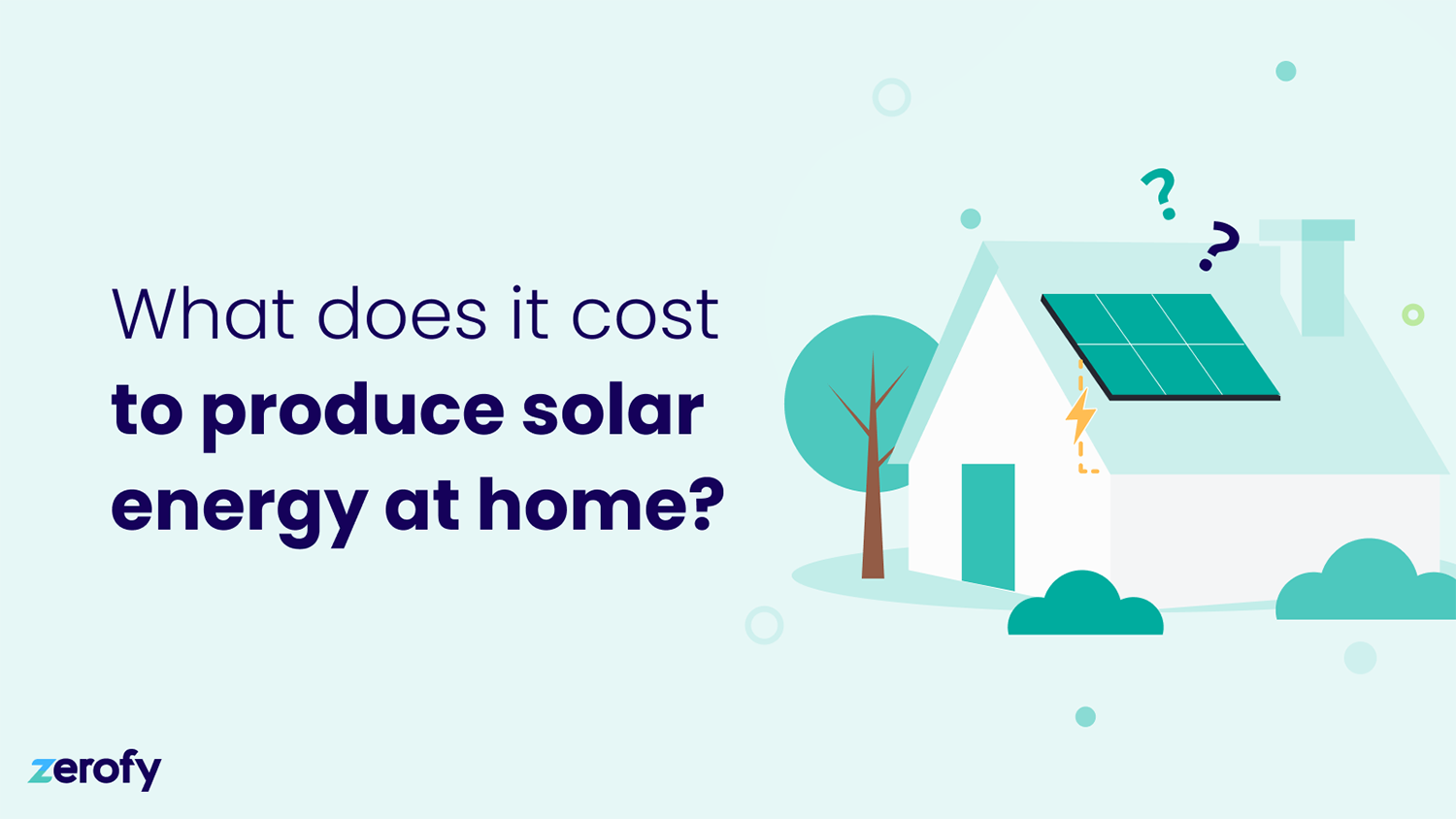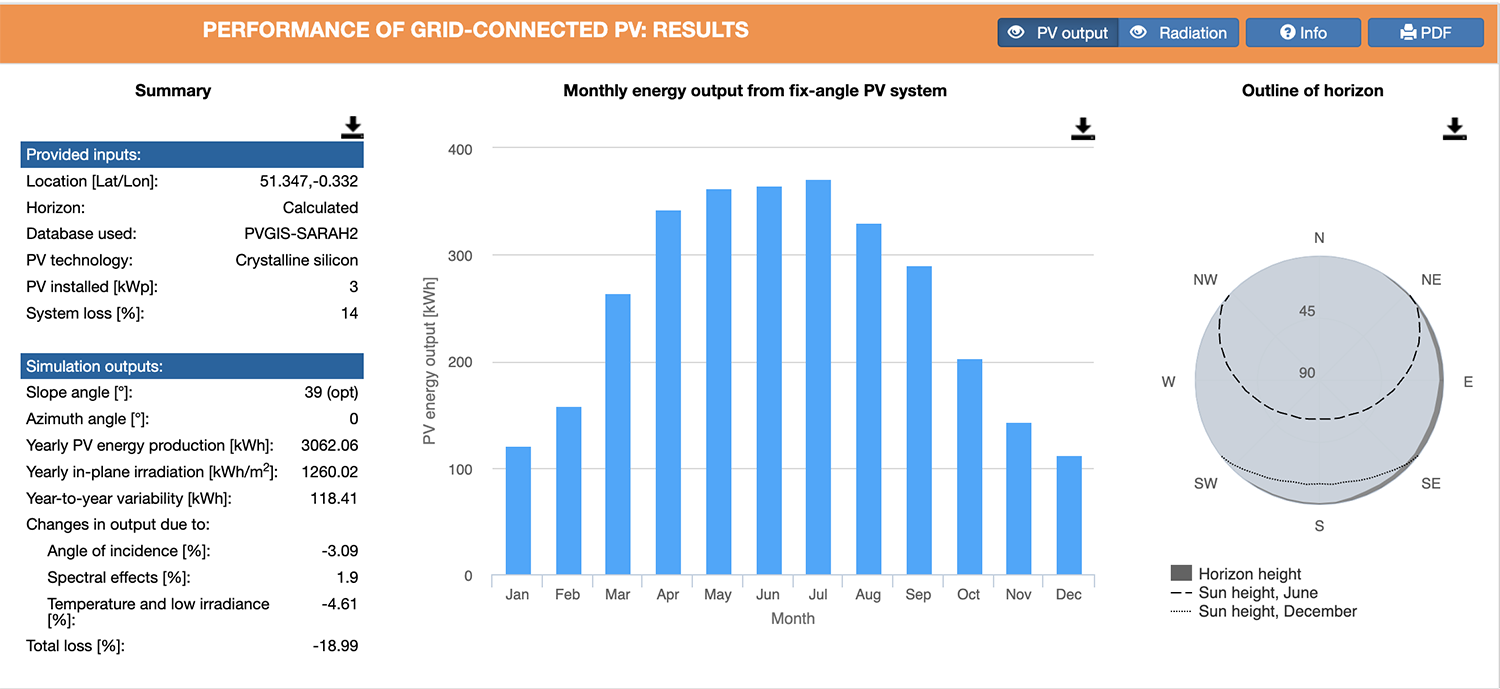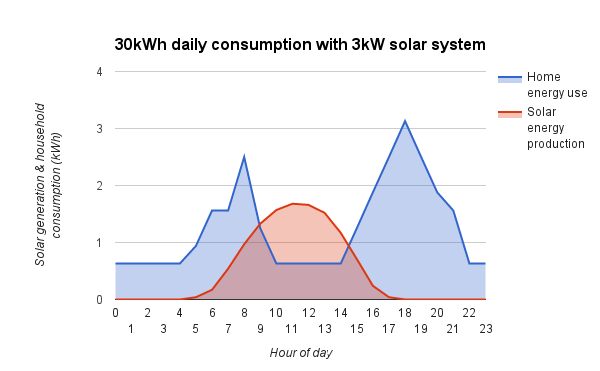
If you’re looking for a high impact way to reduce your household carbon footprint, installing rooftop solar is a great way to go. Depending on where you live, the electricity from the grid will be from a mix of sources, including generation through the burning of coal or natural gas. Electricity powered by solar energy is emissions-free, so when you produce electricity with solar panels, you will be reducing your CO2 emissions. You will also have predictable costs for electricity, and save on your utility bill. Plus, if you feed your excess electricity generated into the grid, you will also be contributing to a grid with lower carbon intensity.
Many people are interested in producing solar energy at home, but have questions about the upfront cost. As with many kinds of household-related infrastructure, the cost will vary. Therefore, for the purpose of this piece, we will be exploring what it could cost to produce rooftop solar at a detached house with three people living in it, located just south of London, UK.
How many solar panels do I need?
To determine how many solar panels you will want on your roof, you will first need to figure out how much electricity on average your household is currently using. You will not only want to examine your yearly consumption, but also how much is being used over typical days/months in summer and winter, which will vary.
There are a few different ways to do this. You can simply reference your utility bill, or if you have a smart meter, you can reference that data for a more granular view. The metric you want to be looking for here is kilowatt hours (kWh). If you have a heat pump or an electric vehicle, their energy consumption will warrant producing more electricity. For example, the annual electricity consumption for an air source heat pump for a typical UK house is 4,000 kWh, while an average electric vehicle driven 10,000 km annually requires 2,000 kWh.
For our scenario, we are in a detached house, with three people living in it, located near London, using 2,900 kWh of electricity each year (the average for a 2-3 person household in the UK). If you’re using the Zerofy app already, you’ll know what your number will be as it is automatically calculated for you.
It is also important to decide whether you want to power your house solely with the solar energy you produce, or if you will be using some grid electricity, and some solar. In this scenario, we will use only solar, and we also want to buy a home battery to store any excess we produce in the summer.
Now that we know that we will need to produce at least 2,900 kWh of electricity per year using our solar panels, we can look at the size of the system we will want to get installed. According to The Renewable Energy Hub UK, the approximate roof size of an average detached house in the UK is 21 m2 - 28 m2, which typically allows for a 3 kilowatt-peak - 4 kilowatt-peak solar system size.
Kilowatt-peak (kWp) refers to the maximum power a solar system can deliver under the best conditions. Typical solar panels used today produce 400-650W (0.4-0.65kW) at ideal sun exposure and temperature. Historically, typical panel sizes were 1.0x2.0m or 1.6x2.0m. Nowadays, the panel sizes can vary from 1.6x2.0m to 1.2x2.3m. The panels are composed of solar cells, with larger panels having more cells (typically panels have 60, 72 or 144 cells). It depends on your roof size and shape which panels will be the most optimal to use.
Now let’s take the area of our roof, the number of panels that would cover it, as well as the wattage per panel. If we assume a panel size of 3m2, we can add between seven and nine panels. However, we actually won’t be able in most cases to cover the entire surface area of the roof (think components like the chimney or parts of the roof’s shape that don’t lend themselves to solar panels). Given this, we will go for six to eight panels. If each solar panel is 500Wp, this would mean we would have an installation that is between 3-4 kWp.
To check that this will meet our needs, we used a great free tool from The European Commission that allows you to view the potential solar energy production for any location on earth. Picking coordinates just south of London and entering that we would have a 3 kWp system size, this tool showed us a potential production of 3,062 kWh, just above our 2,900 kWh annual electricity needs.
One caveat here is that the annual total production is sufficient to cover our electricity needs, but neither the daily nor seasonal household electricity consumption patterns align with the production pattern. As shown below, while the peak solar production is at noon, the consumption peaks are typically in the mornings and evenings. Similarly, on a seasonal basis for locations with cold winters, the consumption in winter is higher than in summer, while the solar production pattern is exactly the opposite. For the daily differences a battery storage can help (see below). For seasonal differences one needs to rely on the electricity grid.
 Screenshot of results from The European Commission’s Photovoltaic Geographical Information System illustrating performance of grid-connected PV for coordinates near London, UK.
Screenshot of results from The European Commission’s Photovoltaic Geographical Information System illustrating performance of grid-connected PV for coordinates near London, UK.
 Graph from Solar Choice illustrating home energy use as well as solar energy production over the course of the day. Note that this shows production on a sunny day; on a day with inconsistent sun, the solar production line (red) would not look as ideal and production would vary more across the span of the day.
Graph from Solar Choice illustrating home energy use as well as solar energy production over the course of the day. Note that this shows production on a sunny day; on a day with inconsistent sun, the solar production line (red) would not look as ideal and production would vary more across the span of the day.
Rooftop solar panels cost
The average cost for a 3 kWp solar panel system in the UK, including panel installation, is between £4,500 and £7,500. Picking the middle point, we can expect to spend £6,000 on our 3 kWp system. It would also be wise to budget a bit of upwards flexibility based on installation complexity, the installer, the kinds of panels being installed, and your location. Based on this, we will put aside £6500 for the installation of our home solar set-up.
View how your electricity use impacts your carbon footprint.
Cost of a home battery
Batteries are increasingly becoming a consideration for those producing solar energy. The main incentive for people to buy batteries is to maximise their own generated solar electricity consumption, in places where there are no problems with the grid supply. There are countries where there is very little compensation for feed-in of solar electricity, but the electricity bought from the grid costs many times more.
Batteries are often installed not only for economic reasons but because house owners like the idea of being independent of the grid and using their own resources as much as possible.
In the UK, home batteries have a large price range, spanning from £1,200 and £6,000. The lifespan of batteries depends on how much use they have, as well as the kind of battery. For example, the manufacturer of the BYD battery HVM 11.0 says it will last for 6,000 cycles or more. With an average of 250 cycles per year, this battery model would have an estimated service life of close to 25 years. These batteries are lithium-iron-phosphate, which last longer than lithium ion batteries. When you buy a battery, make sure to review the expected lifespan from the manufacturer so you can factor in when you may need to replace it.
Learn more about home batteries and how to choose the right one here.
Cost of rooftop solar panel maintenance
Once solar panels are installed, their maintenance needs, and therefore maintenance costs, are quite low. You will want to clean them periodically to remove dirt, dust, leaves, and various other debris from the surface of the panels. This is something you can likely do yourself, without a professional, unless your roof is difficult to access. Luckily, if your panels are tilted, the rain will often take care of this. If you live somewhere with snowfall, the panels should be able to withstand the weight of the snow, but you can clean it off in the spring when you want to maximise production. Your panels can be integrated into your home insurance, which might slightly increase your annual fees, but can cover damage.
Considering solar incentives
Depending on where you live, there may be incentives available to help you fund your home solar set-up. These can take the forms of solar credits, rebates, or other government programs.
The UK has various incentives that households can apply for in 2023. Some of these are funding for home solar based on household income requirements, while some are loans tied to the Green New Deal. The UK used to have a Feed-in-Tariff scheme, but it is no longer operational. In its place is a Smart Export Guarantee, which requires some electricity suppliers to pay small-scale renewable energy producers for electricity, which they export back to the National Grid. It is a good idea to explore the various incentives available in your area to either help with offsetting or financing the cost of your home solar set-up.
How much money will I save with solar panels?
If you know your annual electricity consumption as well as the power prices for your grid, you will be able to calculate savings. In this scenario, we are assuming an electricity price of £0.20/kWh. When we multiply this price by the 3,062 kWh, we find that we would save £612 per year. With these savings, our household would break even on our investment in about 10 years, and from that point on, all of our electricity would be “free.” However, keep in mind that the above figures assume the household is consuming 100% of the produced electricity from the panels, which is often not the case. When surplus energy is fed into the grid, the earnings are lower and based on the current rates.
Note that the above electricity price is at 2020 rates. In 2021, rates were £0.21, and in 2023 some estimates are greater than £0.30. If rates were to stay this high, the time to break even would be significantly shorter.
Rooftop solar in the Zerofy app
The Zerofy app takes some of the hassle out of getting started with rooftop solar. Since your household details and consumption are already known in the app, we will automatically calculate the size of the solar installation you will need. Plus, we calculate how much getting solar will reduce your household carbon footprint, and even connect you with local rooftop solar providers.
Zerofy Shared Solar project
If you are interested in getting rooftop solar, but don’t yet have the funds or access to a roof, you can consider becoming part of Zerofy Shared Solar. We own and operate a 167-panel, 67 kW solar farm in Estonia, where our company is based. You can rent a panel in our farm for €400, and when it generates electricity, you’ll reduce your CO2 emissions, contribute to the growth of solar, and even earn money. Learn more here.